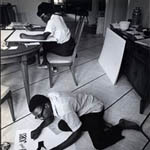By Nika B. Carter, Graduate Assistant, CLIR Hidden Collections Grant, Amistad Research Center at Tulane University
 “Working for Freedom: Documenting Civil Rights Organizations” is a collaborative project between Emory University's Manuscript, Archives and Rare Book Library, The Auburn Avenue Research Library on African American Culture and History, The Amistad Research Center at Tulane University, and The Robert W. Woodruff Library of Atlanta University Center to uncover and make available previously hidden collections documenting the Civil Rights Movement in Atlanta and New Orleans. The project is administered by the Council on Library and Information Resources with funds from the Andrew W. Mellon Foundation. Each organization regularly contributes blog posts about their progress.
“Working for Freedom: Documenting Civil Rights Organizations” is a collaborative project between Emory University's Manuscript, Archives and Rare Book Library, The Auburn Avenue Research Library on African American Culture and History, The Amistad Research Center at Tulane University, and The Robert W. Woodruff Library of Atlanta University Center to uncover and make available previously hidden collections documenting the Civil Rights Movement in Atlanta and New Orleans. The project is administered by the Council on Library and Information Resources with funds from the Andrew W. Mellon Foundation. Each organization regularly contributes blog posts about their progress.
My name is Nika and I’m a graduate student in Museum Studies at Southern University at New Orleans. For the past nine months, I have worked as a graduate assistant at the Amistad Research Center in the processing department. When I first started here, I spent most of my time writing biographical notes and inputting data into Archon, the searchable archival database. I found it to be interesting because I would get the chance to research a historical figure or organization.
Above: Nika Carter
Most recently, I was asked to arrange the newspaper clippings from the James Egert Allen Papers. At first glance, this task seemed like it would take a day or two of work. But, the day or two turned into two weeks! First, I organized the clippings chronologically. Then, I photocopied each article onto acid free paper.
Even though care was taken to preserve the original newspaper clippings, due to the fragile nature of the acid newspaper, several miniscule pieces of disintegrated newspaper clippings were everywhere. Preservation of the text of the newspaper clippings was exactly why I was transferring the clippings to acid-free paper.
Above: Sorting clippings from the James Egert Allen Papers.
While sorting the clippings, I realized that they play a major role in figuring out the context of the times. Besides the focus of the clippings on specific events, I was interested in the adjacent articles. These clippings can be used to give a picture of the culture and fashion of the era in which they were produced. I think that the most thought provoking clippings were articles by J.A. Rogers. James Egert Allen collected the “Your History” clippings from The Pittsburgh Courier.
I came across Rogers’ editorials several times. They captivated me because of the arrangement. Each article had an illustration of the subject Rogers was writing about. I thought that it was an ingenious way of presenting historical information about Black history. I felt enlightened, but unsettled. I wanted to know more about Rogers. I wanted to know more about his background and how he developed his passion for African American history. Also, I wanted to know his role in the documenting of Black history. This is going to be the start of my thesis! I owe it all to the task of photocopying the newspaper clippings. It may have been tedious, but it has become the groundwork of my research.
